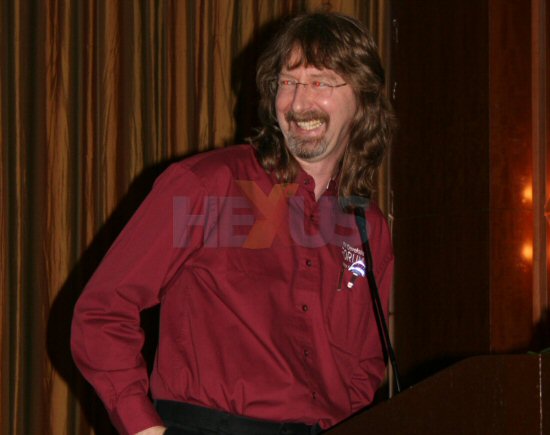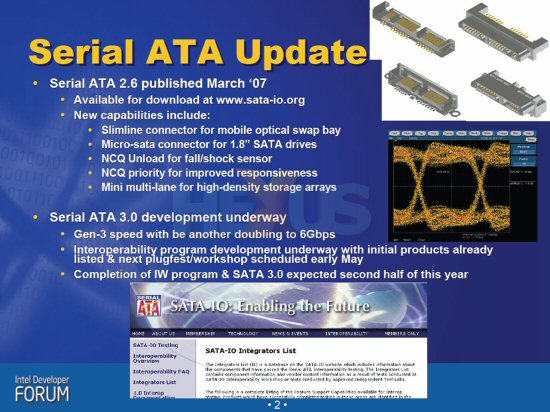ONFI standards set and ONFI v2.0 on the way
 Knut Grimsrud, Director for Intel's Storage Architecture Division (although you'd never realise it by his laid-back look), gave the gathered press an overview of what Intel was doing with respect to storage, with particular interest regarding interfaces.
Knut Grimsrud, Director for Intel's Storage Architecture Division (although you'd never realise it by his laid-back look), gave the gathered press an overview of what Intel was doing with respect to storage, with particular interest regarding interfaces.
Speaking on SATA first, the chairman of the SATA-IO and ONFI organisations reminded us that the SATA v2.6 spec had been passed in March this year. Of note, the new standard details a micro-SATA connector for 1.8in discs, making packaging easier for mobile devices that use these small form-factor drives. It's clear that the new revision addresses the needs of the current market, especially mobile, that weren't envisaged when SATA was first introduced.
 Click for larger image
Click for larger imageNCQ unload, whereby the drives heads are removed from the platters when the drive is deemed to have been dropped, is another feature. It requires a protocol update to ensure that the command is received with the utmost priority.
Knut also commented that SATA v3.0 spec was well underway and was expected to be ratified by the second half of the year. The spec. doubles-up theoretical transfer speed to 6Gbps. We wonder what kind of esoteric RAID array is required to saturate that link? Port multipliers will be needed, probably.
The proliferation of the number of SATA devices means that interoperability is now becoming a more serious issue, and Knut and his team (also long-haired, perhaps?) are looking at ensuring seamless compatibility between devices.
Speaking with his ONFI (Open NAND Flash Interface) hat on, long-haired Knut reiterated that the ONFI v1.0 spec was finalised in December 2006, informing us that there was no previously agreed-upon standard, meaning that previous controllers had to accommodate a number of slightly differing designs.
 Click for larger image
Click for larger imageThe standard now defines the timing, pin-outs, and electricals required to engineer a standard controller that all manufacturers can build their devices to. Further, the standard also covers proposed identification, meaning that a device can be queried for its capacity/speed, much like how USB works.
ONFI v2.0 carries on the standards theme. A faster interface rate is mooted, up to 4x the present speed. v2.0 also covers the definition of a standard connector on to which manufacturers can insert raw NAND modules upon. It's akin to DIMM modules, with a preset number of pins, but which can be laden with various NAND quantities.
Knut highlighted that flash memory's inherent wear-out problem, where it has a limited shelf-life in terms of writing and reading, was being addressed by Intel through the implementation of intelligent algorithms that utilise 'wear-levelling' technology. We'll learn more in the upcoming days, so head back.














